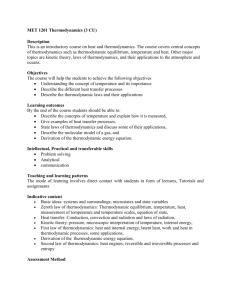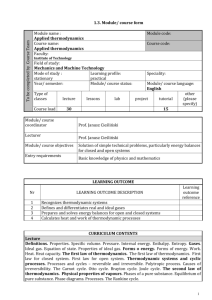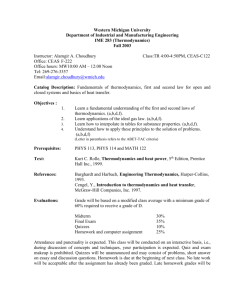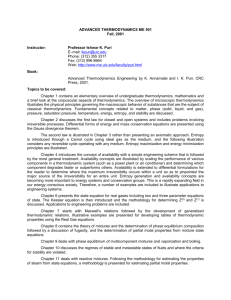Equilibrium Thermodynamics
advertisement
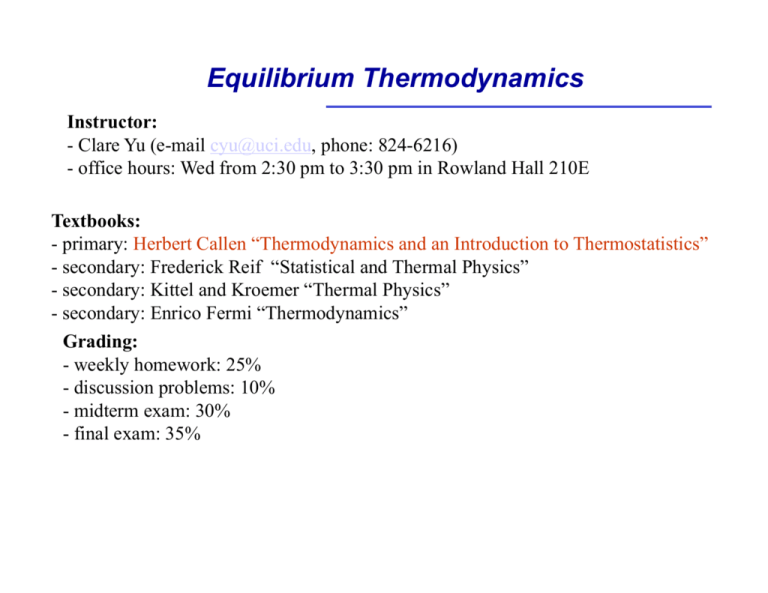
Equilibrium Thermodynamics Instructor: - Clare Yu (e-mail cyu@uci.edu, phone: 824-6216) - office hours: Wed from 2:30 pm to 3:30 pm in Rowland Hall 210E Textbooks: - primary: Herbert Callen “Thermodynamics and an Introduction to Thermostatistics” - secondary: Frederick Reif “Statistical and Thermal Physics” - secondary: Kittel and Kroemer “Thermal Physics” - secondary: Enrico Fermi “Thermodynamics” Grading: - weekly homework: 25% - discussion problems: 10% - midterm exam: 30% - final exam: 35% Equilibrium Thermodynamics Material Covered: Equilibrium thermodynamics, phase transitions, critical phenomena (~ 10 first chapters of Callen’s textbook) Homework: - Homework assignments posted on course website Exams: - One midterm, 80 minutes, Tuesday, May 8 - Final, 2 hours, Tuesday, June 12, 10:30 am - 12:20 pm - All exams are in this room 210M RH Course website is at http://eiffel.ps.uci.edu/cyu/p115B/class.html The Subject of Thermodynamics Thermodynamics describes average properties of macroscopic matter in equilibrium. - Macroscopic matter: large objects that consist of many atoms and molecules. - Average properties: properties (such as volume, pressure, temperature etc) that do not depend on the detailed positions and velocities of atoms and molecules of macroscopic matter. Such quantities are called thermodynamic coordinates, variables or parameters. - Equilibrium: state of a macroscopic system in which all average properties do not change with time. (System is not driven by external driving force.) Why Study Thermodynamics ? - Thermodynamics predicts that the average macroscopic properties of a system in equilibrium are not independent from each other. Therefore, if we measure a subset of these properties, we can calculate the rest of them using thermodynamic relations. - Thermodynamics not only gives the exact description of the state of equilibrium but also provides an approximate description (to a very high degree of precision!) of relatively slow processes. “Slow” means slow compared to the rate of atomic and molecular relaxation processes (which often are fast on the human time scale of seconds and milliseconds). Slow processes have to be slow enough so that an initially homogeneous system remains homogeneous in this process. During such slow processes, system is in quasi-equilibrium because in the process the system goes through a sequence of nearly equilibrium states. Origin of the name: Thermodynamics The name “thermodynamics” stems from the fact that in most cases the macroscopic thermodynamic variables depend on the temperature of the system. Temperature is a physical quantity that is very important in thermodynamics but does not enter into the fundamental equations of other branches of physics such as mechanics, quantum mechanics and electrodynamics. A more appropriate name for equilibrium thermodynamics would be “thermostatics” as the discipline describes systems where time is not important. Time does not enter the equations of thermodynamics! Generality of Thermodynamics - The laws of thermodynamics are very general – they describe any system in equilibrium. This means that a wide variety of physical and chemical systems are described by thermodynamics. - Thermodynamics was formulated in the 18th and 19th centuries, long before the atomistic nature of matter was accepted by the scientific community. (Industrial revolution.) Thermodynamics is so general that it would work even if matter did not consist of atoms and molecules! - The drawback of its generality is that there are a lot of abstract concepts to learn and understand before we can get to interesting applications. As usual, more general theories are more abstract. "Thermodynamics is the only physical theory of universal content which, within the framework of the applicability of its basic concepts, I am convinced will never be overthrown.“ - Albert Einstein How Difficult is Thermodynamics ? - It is very easy, there are only 4 laws (postulates) to learn - It is very difficult because there are many concepts hidden behind these laws that we need to understand "Thermodynamics is a funny subject. The first time you go through it, you don't understand it at all. The second time you go through it, you think you understand it, except for one or two small points. The third time you go through it, you know you don't understand it, but by that time you are so used to it, it doesn't bother you any more." The keys to success: - ask questions, doubt everything - solve lots of problems, as usual - Arnold Sommerfeld Thermodynamics will help us understand … - How do engines and refrigerators work? What are the physical limits on their performance? (Steam engines and the industrial revolution) - Can we predict how the products of a chemical reaction depend on temperature and pressure? - Why are there gases, liquids and solids? What are the laws governing transitions between these phases? - What happens when you mix different substances? Why do alloys generally have lower melting temperature than their constituents? Why is it difficult to make homogeneous alloys? - Why time goes from the past to the future and not vice versa ? Utility of Thermodynamic Description We will see that every macroscopic property of a system in equilibrium can be expressed via a set of a few measurable quantities. For example, every mono-atomic or mono-molecular non-magnetic system is completely described by a set of three quantities and their temperature dependence: (i) coefficient of thermal expansion (ii) compressibility and (iii) heat capacity Microscopic Coordinates If we have a macroscopic body (let’s say a block of metal) consisting of N = 1023 atoms, we can predict its time evolution by solving 3*N = 3* 1023 equations of motion (classical physics approximation, rather poor to start with): M i ai = Fi dXi ∂V (X1 ...X 3N ) Mi =− dt ∂Xi i = 1,..., 3N Solving these equations, we find 3N functions Xi(t) that completely describe the temporal evolution of the system. However, this solution: (i) is impractical (ii) gives a lot of useless information. Macroscopic Thermodynamic Coordinates Let’s consider a block of a metal as an example of a macroscopic system In the macro-world, only macroscopic coordinates such as length (L), width (W) and height (H) of the block of matter. 99.99… % of its microscopic coordinates (positions and velocities of atoms) do not describe its macroscopic behavior directly These macroscopically “invisible” coordinates will be lumped into a single parameter describing the internal degrees of freedom (to be discussed later…). H L W Choice of Thermodynamic Coordinates Identifying the relevant macroscopic coordinates is an art. The choice depends on the particular situation. If we only stretch or compress the block, W, L and H is enough to describe its state If we bend the block, we need to add the bending angles to the macroscopic coordinates If we twist the block, we need to add the twist angles to the macroscopic coordinates A Thermodynamic Coordinate: the Number of Particles - One macroscopic coordinate that we can always use is the number of particles in a macroscopic system. - Since the number of particles is typically very large, it is more convenient to count them in some large portions. - Traditionally, this portion is called “mole”. - It is a relic of the pre-atomic era, where one needed to quantify the “amount of matter” in chemical reactions. Avogadro’s Number One mole contains 6.02217*1023 particles (atoms or molecules). NA = 6.02217 * 1023 is called Avogadro’s number NA is the number of particles in 12 grams of the carbon isotope 12C (equivalently molar mass of 12C is 12 grams) N = Mole number = Number of particles NA Mole Fractions, Molar Volume Coordinates of a multi-component gas or liquid system: (V, N1 … Nm), where Ni are the mole numbers of the components. We can also define the macroscopic coordinates in terms of mole fractions and molar volume: ni = Ni N - mole fractions v= N = Σ Ni V N - molar volume Extensive and Intensive Parameters There are two types of parameters (coordinates) in thermodynamics: - Extensive (their values are proportional to the size of the system) Examples: Volume, Mole Numbers - Intensive (their values do not depend on the size of the system) Examples: Pressure, Temperature, Mole fractions The thermodynamic coordinates we have considered so far are extensive (e. g. length, width, height, volume) Constraints on Extensive Coordinates - As the state of a thermodynamic system evolves with time via a slow, quasi-equilibrium process, the values of some extensive parameters may vary while the values of other extensive parameters may be fixed by interaction with the system’s environment (walls, membranes etc). - For example, the number of gas molecules in a sealed bottle is fixed. Therefore, the number of moles of the gas of such a system are constrained. - If we have an open bottle, the number of gas molecules inside of the bottle may change if we change some other parameter (e. g. room pressure or temperature). In this case, mole numbers are not constrained. Internal Energy - A macroscopic system possesses a well-defined energy, which consists of the kinetic energy of atoms and molecules in the rest frame of the center of mass of the system and the energy of interaction between them (internal potential energy). - In thermodynamics, this total energy of the system is called the internal energy U. - As usual, the total energy is defined up to an arbitrary constant. Only energy differences are physically meaningful. - Internal energy U is an extensive thermodynamic coordinate (a subtle point, this is only valid when interactions are short-range). Adiabatic Processes and Heat - It is possible to increase the internal energy U of a system by doing work W on this system. For example, mechanical work done by the friction force transfers energy to the tires of a car. As a result, the atoms in tires vibrate at larger amplitudes and the tires warm up. - Heat Q is energy transfer between systems done without work. For example, on a sunny day tires warm up from energy flow from the Sun. Tires do not move, so no work is done but energy is transferred to tires via heat. - If no heat is allowed to flow into or out of a system during a quasi-equilibrium process, this process is called adiabatic. - We will often talk about “adiabatic walls” separating thermodynamic systems. Such walls do not allow heat transfer. Walls that allow heat transfer are called “diathermal”. Internal Energy, Heat and Work There are only two ways of changing the internal energy of a system with fixed (constrained) mole numbers: - Work, δW, done by external forces on the system (energy transferred to the system via its macroscopic degrees of freedom) - Transfer of energy by means of heat, δQ, (energy transferred directly to the microscopic degrees of freedom) δW work Liquid or gas F heat δQ dx δW = - F*dx = - P*S*dx = - P*dV S = piston area; F = force; P = pressure Conservation of Energy: dU (V, N1 … Nm, …) = δW + δQ


